Heart Disease Symptoms
VerifiedAdded on 2022/09/13
|15
|3768
|12
AI Summary
Contribute Materials
Your contribution can guide someone’s learning journey. Share your
documents today.
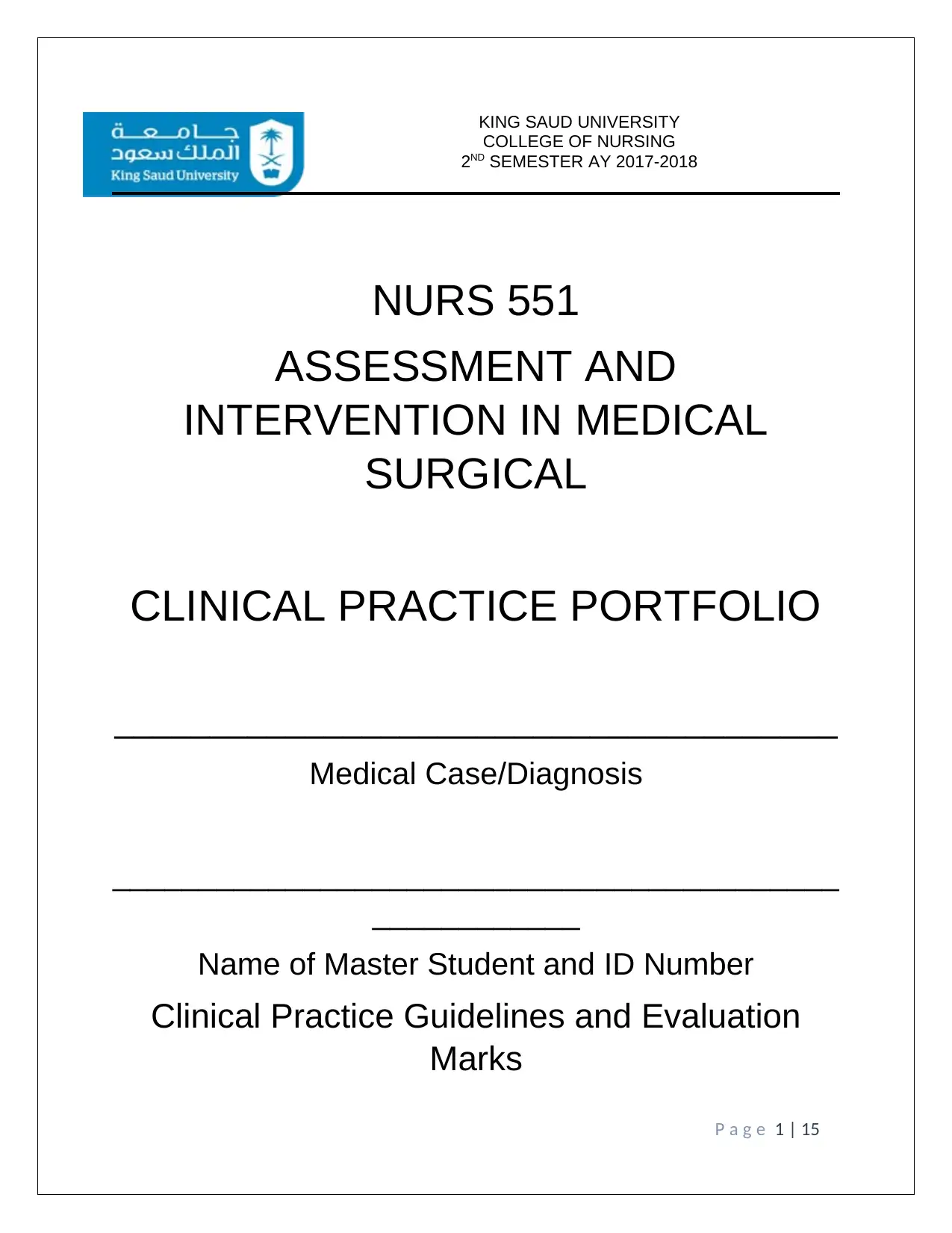
KING SAUD UNIVERSITY
COLLEGE OF NURSING
2ND SEMESTER AY 2017-2018
NURS 551
ASSESSMENT AND
INTERVENTION IN MEDICAL
SURGICAL
CLINICAL PRACTICE PORTFOLIO
______________________________________
Medical Case/Diagnosis
__________________________________________
____________
Name of Master Student and ID Number
Clinical Practice Guidelines and Evaluation
Marks
P a g e 1 | 15
COLLEGE OF NURSING
2ND SEMESTER AY 2017-2018
NURS 551
ASSESSMENT AND
INTERVENTION IN MEDICAL
SURGICAL
CLINICAL PRACTICE PORTFOLIO
______________________________________
Medical Case/Diagnosis
__________________________________________
____________
Name of Master Student and ID Number
Clinical Practice Guidelines and Evaluation
Marks
P a g e 1 | 15
Secure Best Marks with AI Grader
Need help grading? Try our AI Grader for instant feedback on your assignments.
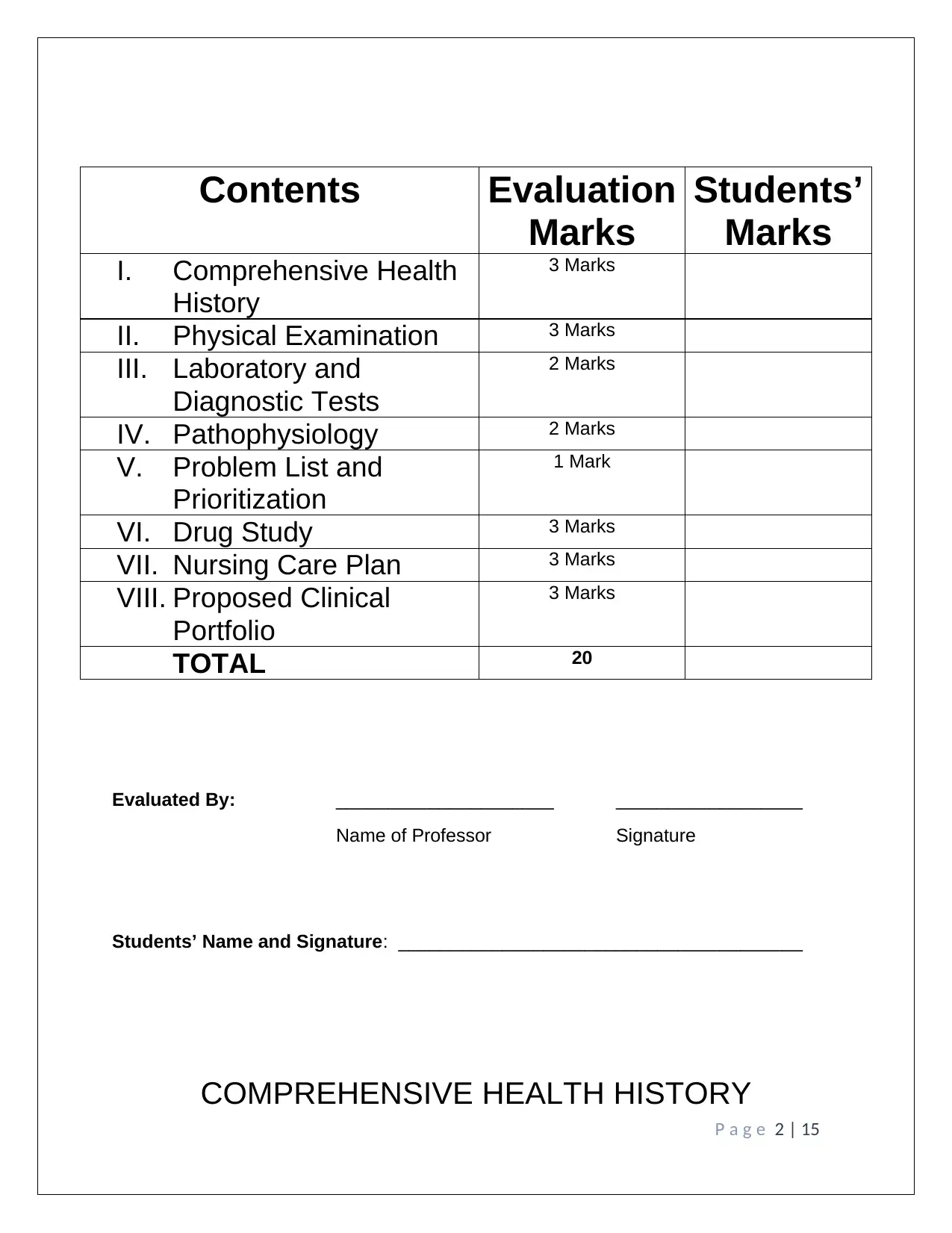
Contents Evaluation
Marks
Students’
Marks
I. Comprehensive Health
History
3 Marks
II. Physical Examination 3 Marks
III. Laboratory and
Diagnostic Tests
2 Marks
IV. Pathophysiology 2 Marks
V. Problem List and
Prioritization
1 Mark
VI. Drug Study 3 Marks
VII. Nursing Care Plan 3 Marks
VIII. Proposed Clinical
Portfolio
3 Marks
TOTAL 20
Evaluated By: _____________________ __________________
Name of Professor Signature
Students’ Name and Signature: _______________________________________
COMPREHENSIVE HEALTH HISTORY
P a g e 2 | 15
Marks
Students’
Marks
I. Comprehensive Health
History
3 Marks
II. Physical Examination 3 Marks
III. Laboratory and
Diagnostic Tests
2 Marks
IV. Pathophysiology 2 Marks
V. Problem List and
Prioritization
1 Mark
VI. Drug Study 3 Marks
VII. Nursing Care Plan 3 Marks
VIII. Proposed Clinical
Portfolio
3 Marks
TOTAL 20
Evaluated By: _____________________ __________________
Name of Professor Signature
Students’ Name and Signature: _______________________________________
COMPREHENSIVE HEALTH HISTORY
P a g e 2 | 15
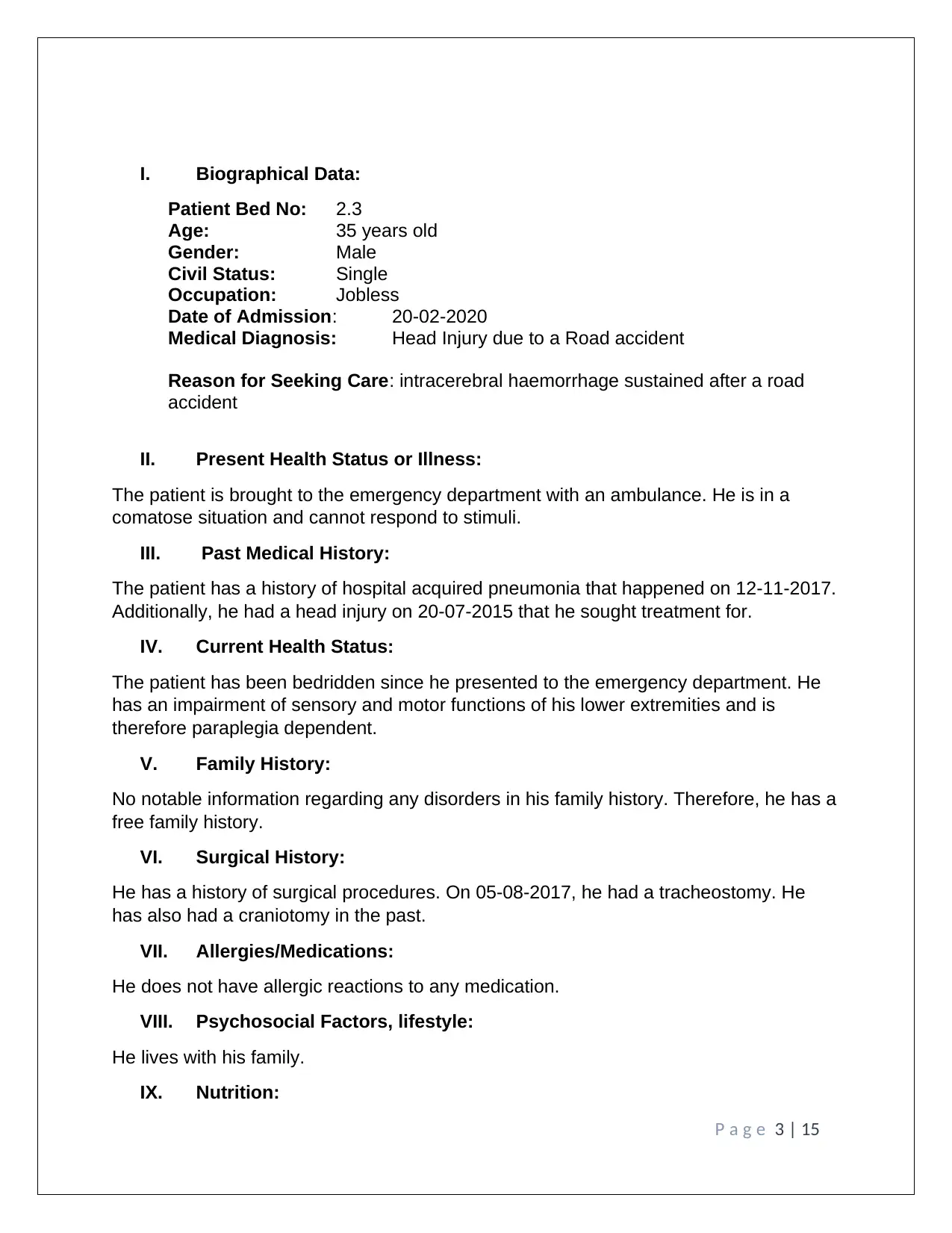
I. Biographical Data:
Patient Bed No: 2.3
Age: 35 years old
Gender: Male
Civil Status: Single
Occupation: Jobless
Date of Admission: 20-02-2020
Medical Diagnosis: Head Injury due to a Road accident
Reason for Seeking Care: intracerebral haemorrhage sustained after a road
accident
II. Present Health Status or Illness:
The patient is brought to the emergency department with an ambulance. He is in a
comatose situation and cannot respond to stimuli.
III. Past Medical History:
The patient has a history of hospital acquired pneumonia that happened on 12-11-2017.
Additionally, he had a head injury on 20-07-2015 that he sought treatment for.
IV. Current Health Status:
The patient has been bedridden since he presented to the emergency department. He
has an impairment of sensory and motor functions of his lower extremities and is
therefore paraplegia dependent.
V. Family History:
No notable information regarding any disorders in his family history. Therefore, he has a
free family history.
VI. Surgical History:
He has a history of surgical procedures. On 05-08-2017, he had a tracheostomy. He
has also had a craniotomy in the past.
VII. Allergies/Medications:
He does not have allergic reactions to any medication.
VIII. Psychosocial Factors, lifestyle:
He lives with his family.
IX. Nutrition:
P a g e 3 | 15
Patient Bed No: 2.3
Age: 35 years old
Gender: Male
Civil Status: Single
Occupation: Jobless
Date of Admission: 20-02-2020
Medical Diagnosis: Head Injury due to a Road accident
Reason for Seeking Care: intracerebral haemorrhage sustained after a road
accident
II. Present Health Status or Illness:
The patient is brought to the emergency department with an ambulance. He is in a
comatose situation and cannot respond to stimuli.
III. Past Medical History:
The patient has a history of hospital acquired pneumonia that happened on 12-11-2017.
Additionally, he had a head injury on 20-07-2015 that he sought treatment for.
IV. Current Health Status:
The patient has been bedridden since he presented to the emergency department. He
has an impairment of sensory and motor functions of his lower extremities and is
therefore paraplegia dependent.
V. Family History:
No notable information regarding any disorders in his family history. Therefore, he has a
free family history.
VI. Surgical History:
He has a history of surgical procedures. On 05-08-2017, he had a tracheostomy. He
has also had a craniotomy in the past.
VII. Allergies/Medications:
He does not have allergic reactions to any medication.
VIII. Psychosocial Factors, lifestyle:
He lives with his family.
IX. Nutrition:
P a g e 3 | 15
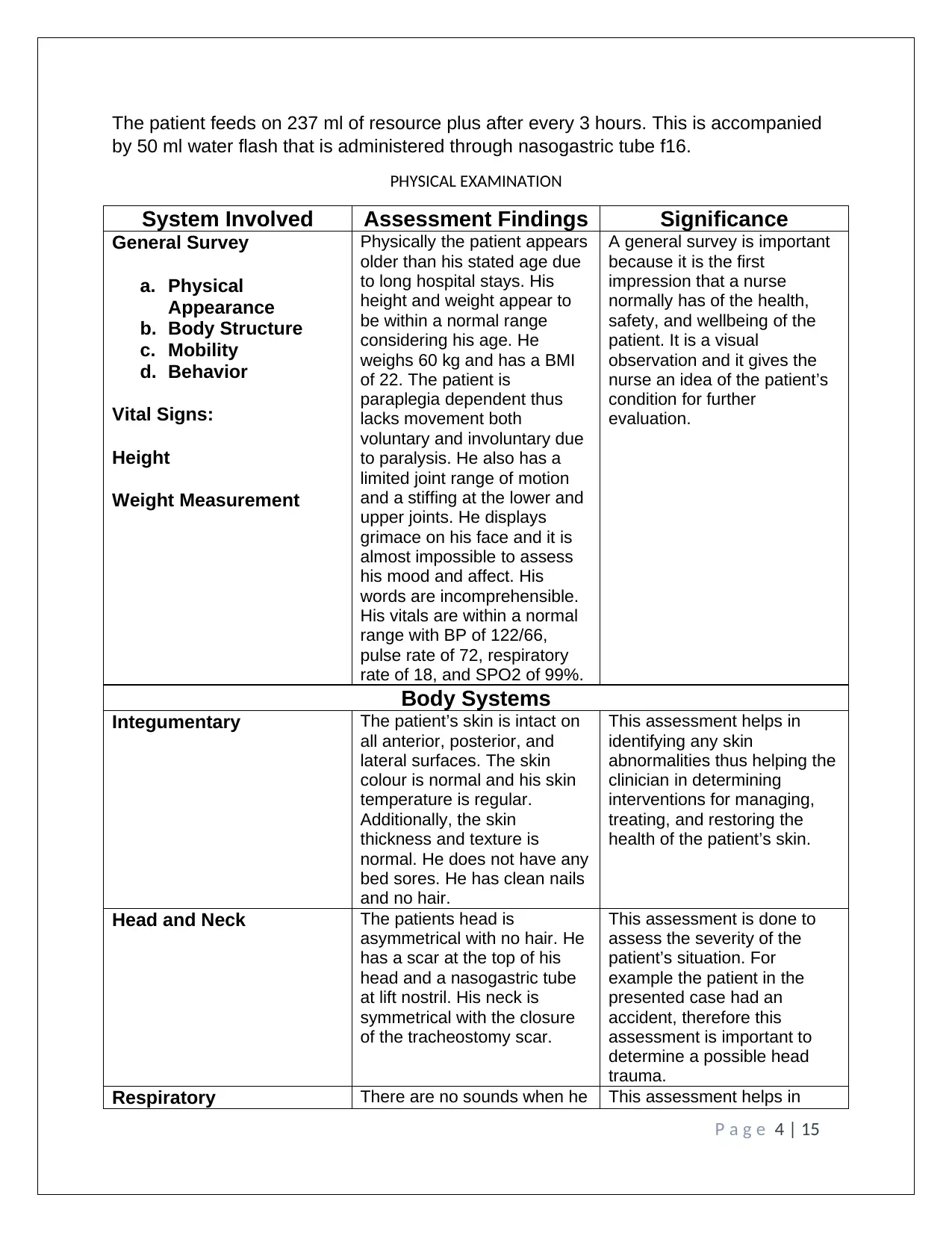
The patient feeds on 237 ml of resource plus after every 3 hours. This is accompanied
by 50 ml water flash that is administered through nasogastric tube f16.
PHYSICAL EXAMINATION
System Involved Assessment Findings Significance
General Survey
a. Physical
Appearance
b. Body Structure
c. Mobility
d. Behavior
Vital Signs:
Height
Weight Measurement
Physically the patient appears
older than his stated age due
to long hospital stays. His
height and weight appear to
be within a normal range
considering his age. He
weighs 60 kg and has a BMI
of 22. The patient is
paraplegia dependent thus
lacks movement both
voluntary and involuntary due
to paralysis. He also has a
limited joint range of motion
and a stiffing at the lower and
upper joints. He displays
grimace on his face and it is
almost impossible to assess
his mood and affect. His
words are incomprehensible.
His vitals are within a normal
range with BP of 122/66,
pulse rate of 72, respiratory
rate of 18, and SPO2 of 99%.
A general survey is important
because it is the first
impression that a nurse
normally has of the health,
safety, and wellbeing of the
patient. It is a visual
observation and it gives the
nurse an idea of the patient’s
condition for further
evaluation.
Body Systems
Integumentary The patient’s skin is intact on
all anterior, posterior, and
lateral surfaces. The skin
colour is normal and his skin
temperature is regular.
Additionally, the skin
thickness and texture is
normal. He does not have any
bed sores. He has clean nails
and no hair.
This assessment helps in
identifying any skin
abnormalities thus helping the
clinician in determining
interventions for managing,
treating, and restoring the
health of the patient’s skin.
Head and Neck The patients head is
asymmetrical with no hair. He
has a scar at the top of his
head and a nasogastric tube
at lift nostril. His neck is
symmetrical with the closure
of the tracheostomy scar.
This assessment is done to
assess the severity of the
patient’s situation. For
example the patient in the
presented case had an
accident, therefore this
assessment is important to
determine a possible head
trauma.
Respiratory There are no sounds when he This assessment helps in
P a g e 4 | 15
by 50 ml water flash that is administered through nasogastric tube f16.
PHYSICAL EXAMINATION
System Involved Assessment Findings Significance
General Survey
a. Physical
Appearance
b. Body Structure
c. Mobility
d. Behavior
Vital Signs:
Height
Weight Measurement
Physically the patient appears
older than his stated age due
to long hospital stays. His
height and weight appear to
be within a normal range
considering his age. He
weighs 60 kg and has a BMI
of 22. The patient is
paraplegia dependent thus
lacks movement both
voluntary and involuntary due
to paralysis. He also has a
limited joint range of motion
and a stiffing at the lower and
upper joints. He displays
grimace on his face and it is
almost impossible to assess
his mood and affect. His
words are incomprehensible.
His vitals are within a normal
range with BP of 122/66,
pulse rate of 72, respiratory
rate of 18, and SPO2 of 99%.
A general survey is important
because it is the first
impression that a nurse
normally has of the health,
safety, and wellbeing of the
patient. It is a visual
observation and it gives the
nurse an idea of the patient’s
condition for further
evaluation.
Body Systems
Integumentary The patient’s skin is intact on
all anterior, posterior, and
lateral surfaces. The skin
colour is normal and his skin
temperature is regular.
Additionally, the skin
thickness and texture is
normal. He does not have any
bed sores. He has clean nails
and no hair.
This assessment helps in
identifying any skin
abnormalities thus helping the
clinician in determining
interventions for managing,
treating, and restoring the
health of the patient’s skin.
Head and Neck The patients head is
asymmetrical with no hair. He
has a scar at the top of his
head and a nasogastric tube
at lift nostril. His neck is
symmetrical with the closure
of the tracheostomy scar.
This assessment is done to
assess the severity of the
patient’s situation. For
example the patient in the
presented case had an
accident, therefore this
assessment is important to
determine a possible head
trauma.
Respiratory There are no sounds when he This assessment helps in
P a g e 4 | 15
Secure Best Marks with AI Grader
Need help grading? Try our AI Grader for instant feedback on your assignments.
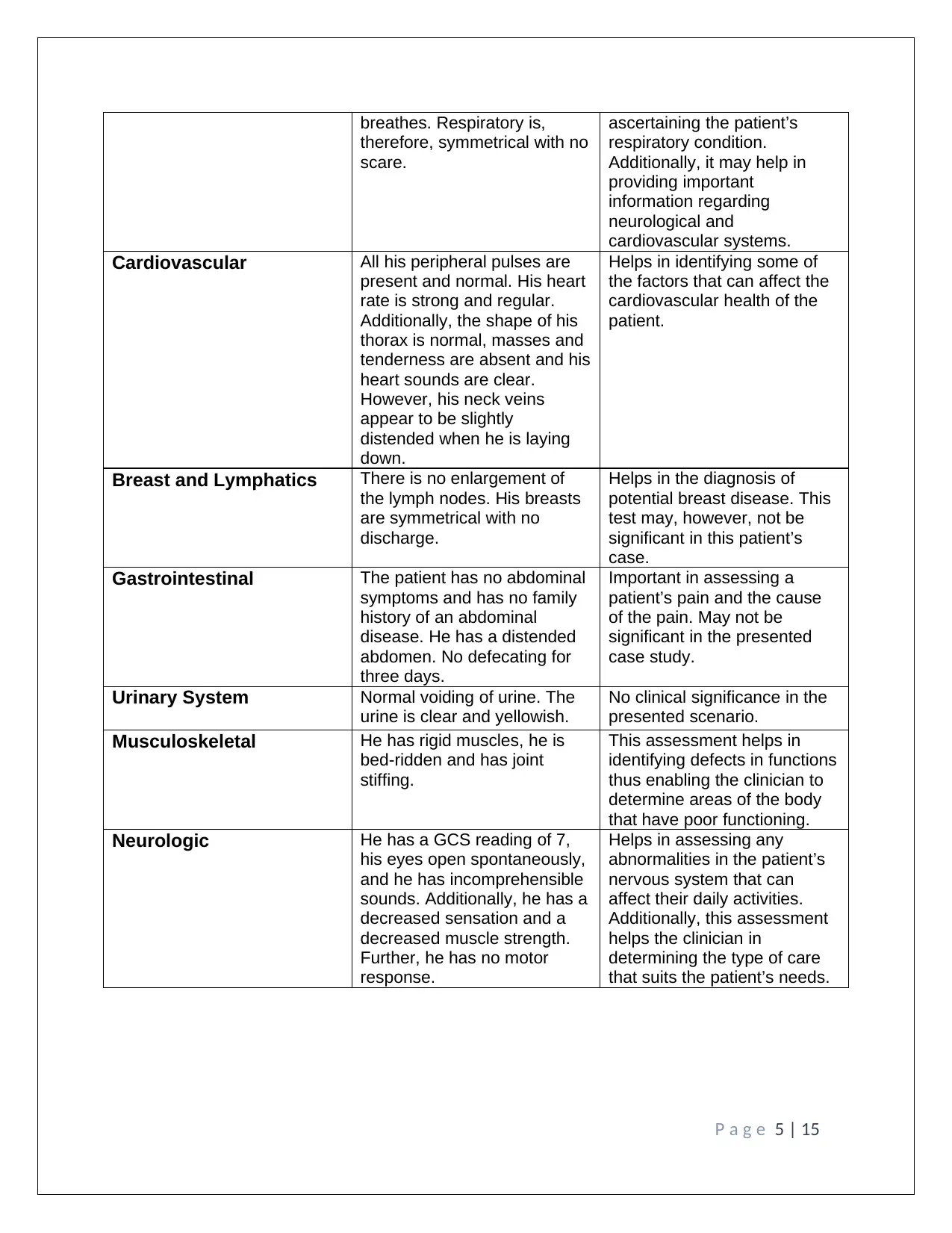
breathes. Respiratory is,
therefore, symmetrical with no
scare.
ascertaining the patient’s
respiratory condition.
Additionally, it may help in
providing important
information regarding
neurological and
cardiovascular systems.
Cardiovascular All his peripheral pulses are
present and normal. His heart
rate is strong and regular.
Additionally, the shape of his
thorax is normal, masses and
tenderness are absent and his
heart sounds are clear.
However, his neck veins
appear to be slightly
distended when he is laying
down.
Helps in identifying some of
the factors that can affect the
cardiovascular health of the
patient.
Breast and Lymphatics There is no enlargement of
the lymph nodes. His breasts
are symmetrical with no
discharge.
Helps in the diagnosis of
potential breast disease. This
test may, however, not be
significant in this patient’s
case.
Gastrointestinal The patient has no abdominal
symptoms and has no family
history of an abdominal
disease. He has a distended
abdomen. No defecating for
three days.
Important in assessing a
patient’s pain and the cause
of the pain. May not be
significant in the presented
case study.
Urinary System Normal voiding of urine. The
urine is clear and yellowish.
No clinical significance in the
presented scenario.
Musculoskeletal He has rigid muscles, he is
bed-ridden and has joint
stiffing.
This assessment helps in
identifying defects in functions
thus enabling the clinician to
determine areas of the body
that have poor functioning.
Neurologic He has a GCS reading of 7,
his eyes open spontaneously,
and he has incomprehensible
sounds. Additionally, he has a
decreased sensation and a
decreased muscle strength.
Further, he has no motor
response.
Helps in assessing any
abnormalities in the patient’s
nervous system that can
affect their daily activities.
Additionally, this assessment
helps the clinician in
determining the type of care
that suits the patient’s needs.
P a g e 5 | 15
therefore, symmetrical with no
scare.
ascertaining the patient’s
respiratory condition.
Additionally, it may help in
providing important
information regarding
neurological and
cardiovascular systems.
Cardiovascular All his peripheral pulses are
present and normal. His heart
rate is strong and regular.
Additionally, the shape of his
thorax is normal, masses and
tenderness are absent and his
heart sounds are clear.
However, his neck veins
appear to be slightly
distended when he is laying
down.
Helps in identifying some of
the factors that can affect the
cardiovascular health of the
patient.
Breast and Lymphatics There is no enlargement of
the lymph nodes. His breasts
are symmetrical with no
discharge.
Helps in the diagnosis of
potential breast disease. This
test may, however, not be
significant in this patient’s
case.
Gastrointestinal The patient has no abdominal
symptoms and has no family
history of an abdominal
disease. He has a distended
abdomen. No defecating for
three days.
Important in assessing a
patient’s pain and the cause
of the pain. May not be
significant in the presented
case study.
Urinary System Normal voiding of urine. The
urine is clear and yellowish.
No clinical significance in the
presented scenario.
Musculoskeletal He has rigid muscles, he is
bed-ridden and has joint
stiffing.
This assessment helps in
identifying defects in functions
thus enabling the clinician to
determine areas of the body
that have poor functioning.
Neurologic He has a GCS reading of 7,
his eyes open spontaneously,
and he has incomprehensible
sounds. Additionally, he has a
decreased sensation and a
decreased muscle strength.
Further, he has no motor
response.
Helps in assessing any
abnormalities in the patient’s
nervous system that can
affect their daily activities.
Additionally, this assessment
helps the clinician in
determining the type of care
that suits the patient’s needs.
P a g e 5 | 15
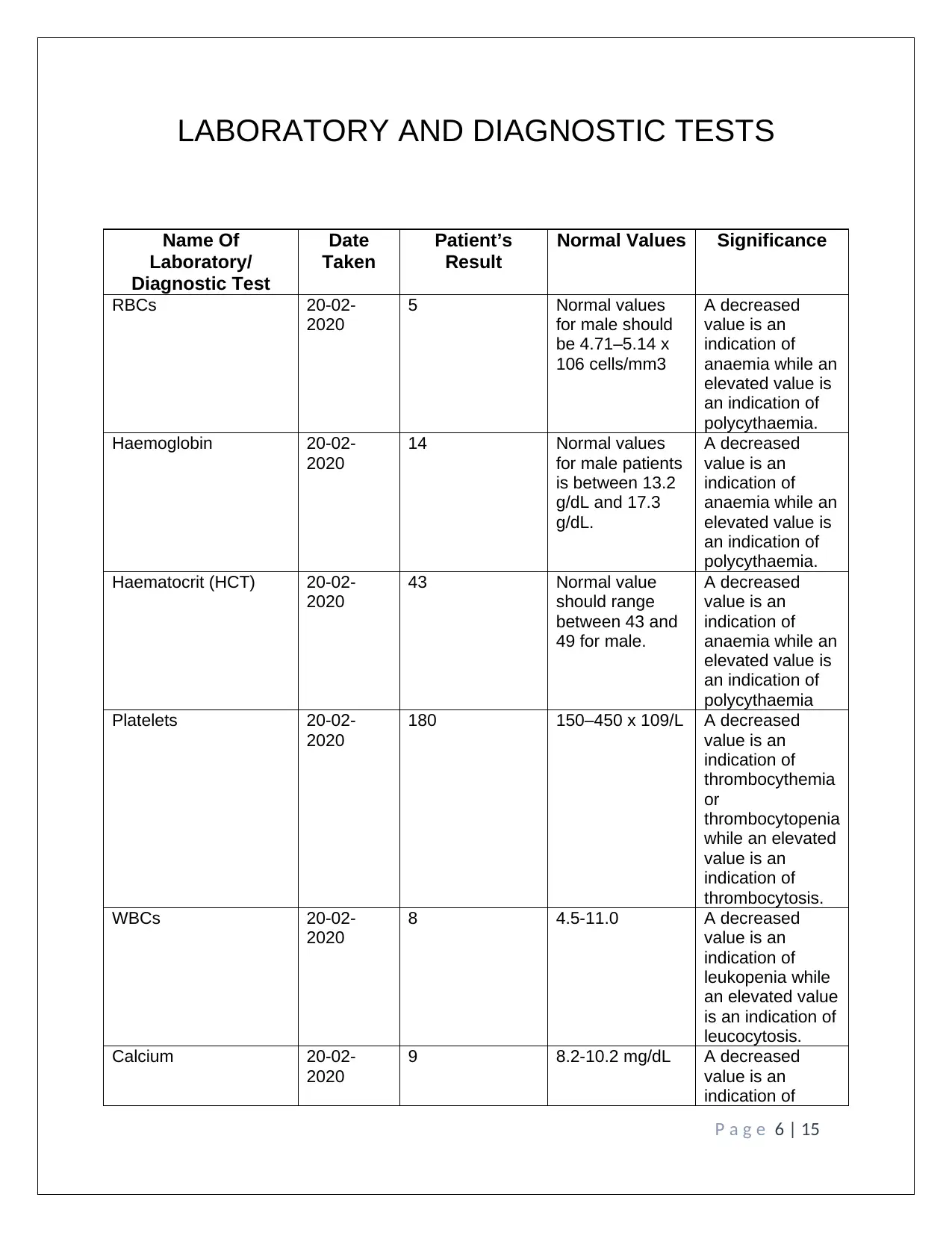
LABORATORY AND DIAGNOSTIC TESTS
Name Of
Laboratory/
Diagnostic Test
Date
Taken
Patient’s
Result
Normal Values Significance
RBCs 20-02-
2020
5 Normal values
for male should
be 4.71–5.14 x
106 cells/mm3
A decreased
value is an
indication of
anaemia while an
elevated value is
an indication of
polycythaemia.
Haemoglobin 20-02-
2020
14 Normal values
for male patients
is between 13.2
g/dL and 17.3
g/dL.
A decreased
value is an
indication of
anaemia while an
elevated value is
an indication of
polycythaemia.
Haematocrit (HCT) 20-02-
2020
43 Normal value
should range
between 43 and
49 for male.
A decreased
value is an
indication of
anaemia while an
elevated value is
an indication of
polycythaemia
Platelets 20-02-
2020
180 150–450 x 109/L A decreased
value is an
indication of
thrombocythemia
or
thrombocytopenia
while an elevated
value is an
indication of
thrombocytosis.
WBCs 20-02-
2020
8 4.5-11.0 A decreased
value is an
indication of
leukopenia while
an elevated value
is an indication of
leucocytosis.
Calcium 20-02-
2020
9 8.2-10.2 mg/dL A decreased
value is an
indication of
P a g e 6 | 15
Name Of
Laboratory/
Diagnostic Test
Date
Taken
Patient’s
Result
Normal Values Significance
RBCs 20-02-
2020
5 Normal values
for male should
be 4.71–5.14 x
106 cells/mm3
A decreased
value is an
indication of
anaemia while an
elevated value is
an indication of
polycythaemia.
Haemoglobin 20-02-
2020
14 Normal values
for male patients
is between 13.2
g/dL and 17.3
g/dL.
A decreased
value is an
indication of
anaemia while an
elevated value is
an indication of
polycythaemia.
Haematocrit (HCT) 20-02-
2020
43 Normal value
should range
between 43 and
49 for male.
A decreased
value is an
indication of
anaemia while an
elevated value is
an indication of
polycythaemia
Platelets 20-02-
2020
180 150–450 x 109/L A decreased
value is an
indication of
thrombocythemia
or
thrombocytopenia
while an elevated
value is an
indication of
thrombocytosis.
WBCs 20-02-
2020
8 4.5-11.0 A decreased
value is an
indication of
leukopenia while
an elevated value
is an indication of
leucocytosis.
Calcium 20-02-
2020
9 8.2-10.2 mg/dL A decreased
value is an
indication of
P a g e 6 | 15
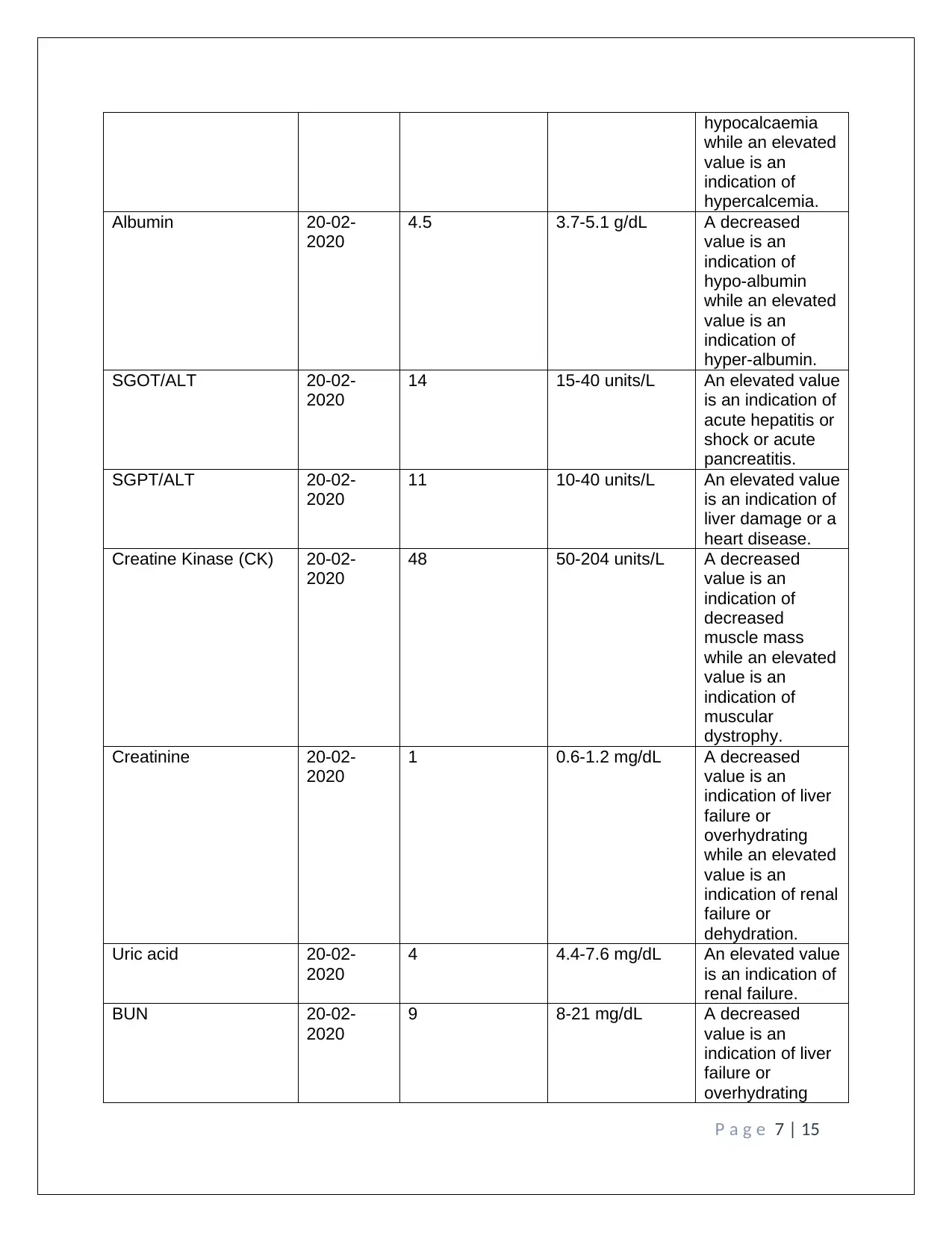
hypocalcaemia
while an elevated
value is an
indication of
hypercalcemia.
Albumin 20-02-
2020
4.5 3.7-5.1 g/dL A decreased
value is an
indication of
hypo-albumin
while an elevated
value is an
indication of
hyper-albumin.
SGOT/ALT 20-02-
2020
14 15-40 units/L An elevated value
is an indication of
acute hepatitis or
shock or acute
pancreatitis.
SGPT/ALT 20-02-
2020
11 10-40 units/L An elevated value
is an indication of
liver damage or a
heart disease.
Creatine Kinase (CK) 20-02-
2020
48 50-204 units/L A decreased
value is an
indication of
decreased
muscle mass
while an elevated
value is an
indication of
muscular
dystrophy.
Creatinine 20-02-
2020
1 0.6-1.2 mg/dL A decreased
value is an
indication of liver
failure or
overhydrating
while an elevated
value is an
indication of renal
failure or
dehydration.
Uric acid 20-02-
2020
4 4.4-7.6 mg/dL An elevated value
is an indication of
renal failure.
BUN 20-02-
2020
9 8-21 mg/dL A decreased
value is an
indication of liver
failure or
overhydrating
P a g e 7 | 15
while an elevated
value is an
indication of
hypercalcemia.
Albumin 20-02-
2020
4.5 3.7-5.1 g/dL A decreased
value is an
indication of
hypo-albumin
while an elevated
value is an
indication of
hyper-albumin.
SGOT/ALT 20-02-
2020
14 15-40 units/L An elevated value
is an indication of
acute hepatitis or
shock or acute
pancreatitis.
SGPT/ALT 20-02-
2020
11 10-40 units/L An elevated value
is an indication of
liver damage or a
heart disease.
Creatine Kinase (CK) 20-02-
2020
48 50-204 units/L A decreased
value is an
indication of
decreased
muscle mass
while an elevated
value is an
indication of
muscular
dystrophy.
Creatinine 20-02-
2020
1 0.6-1.2 mg/dL A decreased
value is an
indication of liver
failure or
overhydrating
while an elevated
value is an
indication of renal
failure or
dehydration.
Uric acid 20-02-
2020
4 4.4-7.6 mg/dL An elevated value
is an indication of
renal failure.
BUN 20-02-
2020
9 8-21 mg/dL A decreased
value is an
indication of liver
failure or
overhydrating
P a g e 7 | 15
Paraphrase This Document
Need a fresh take? Get an instant paraphrase of this document with our AI Paraphraser
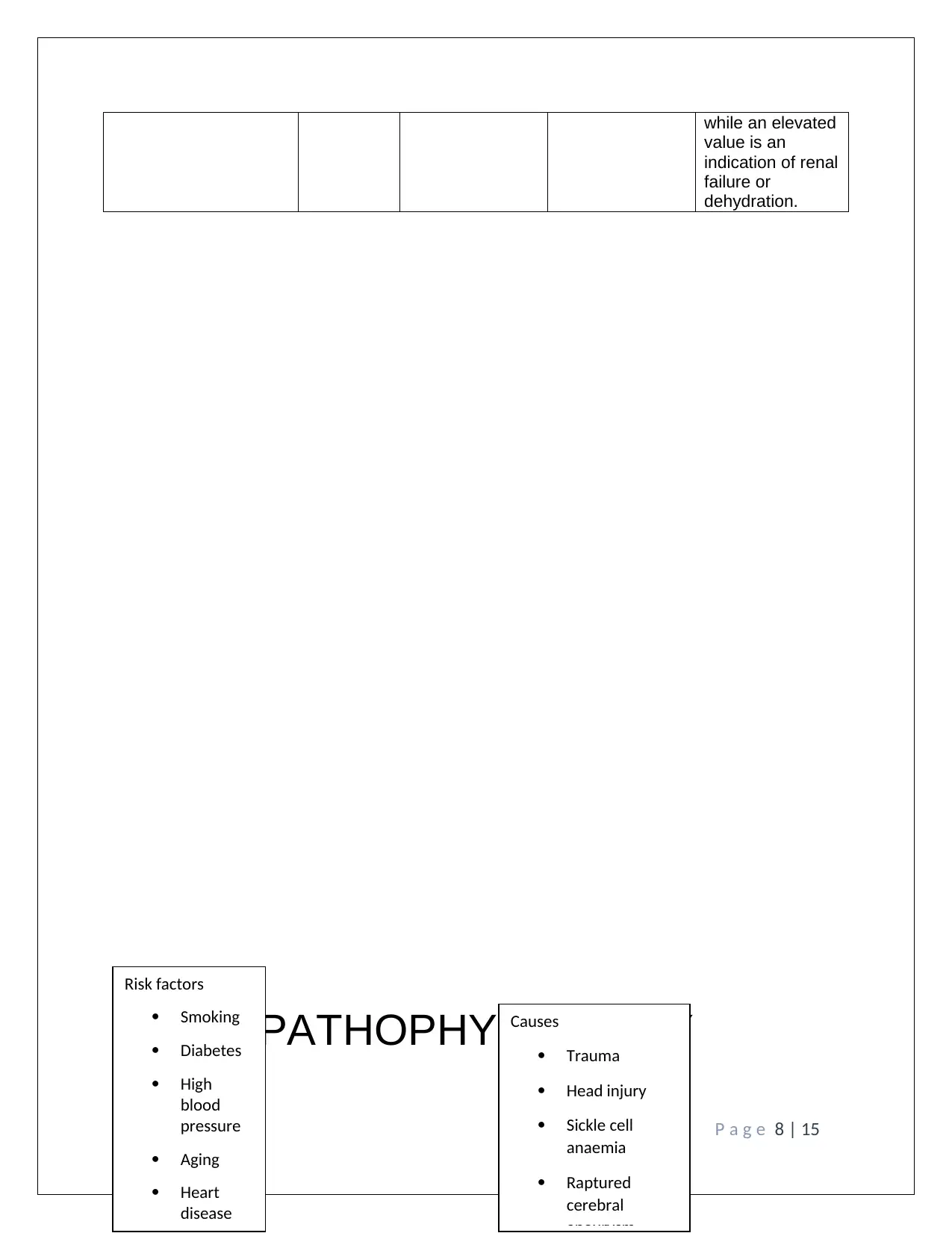
while an elevated
value is an
indication of renal
failure or
dehydration.
PATHOPHYSIOLOGY
P a g e 8 | 15
Risk factors
Smoking
Diabetes
High
blood
pressure
Aging
Heart
disease
Causes
Trauma
Head injury
Sickle cell
anaemia
Raptured
cerebral
value is an
indication of renal
failure or
dehydration.
PATHOPHYSIOLOGY
P a g e 8 | 15
Risk factors
Smoking
Diabetes
High
blood
pressure
Aging
Heart
disease
Causes
Trauma
Head injury
Sickle cell
anaemia
Raptured
cerebral
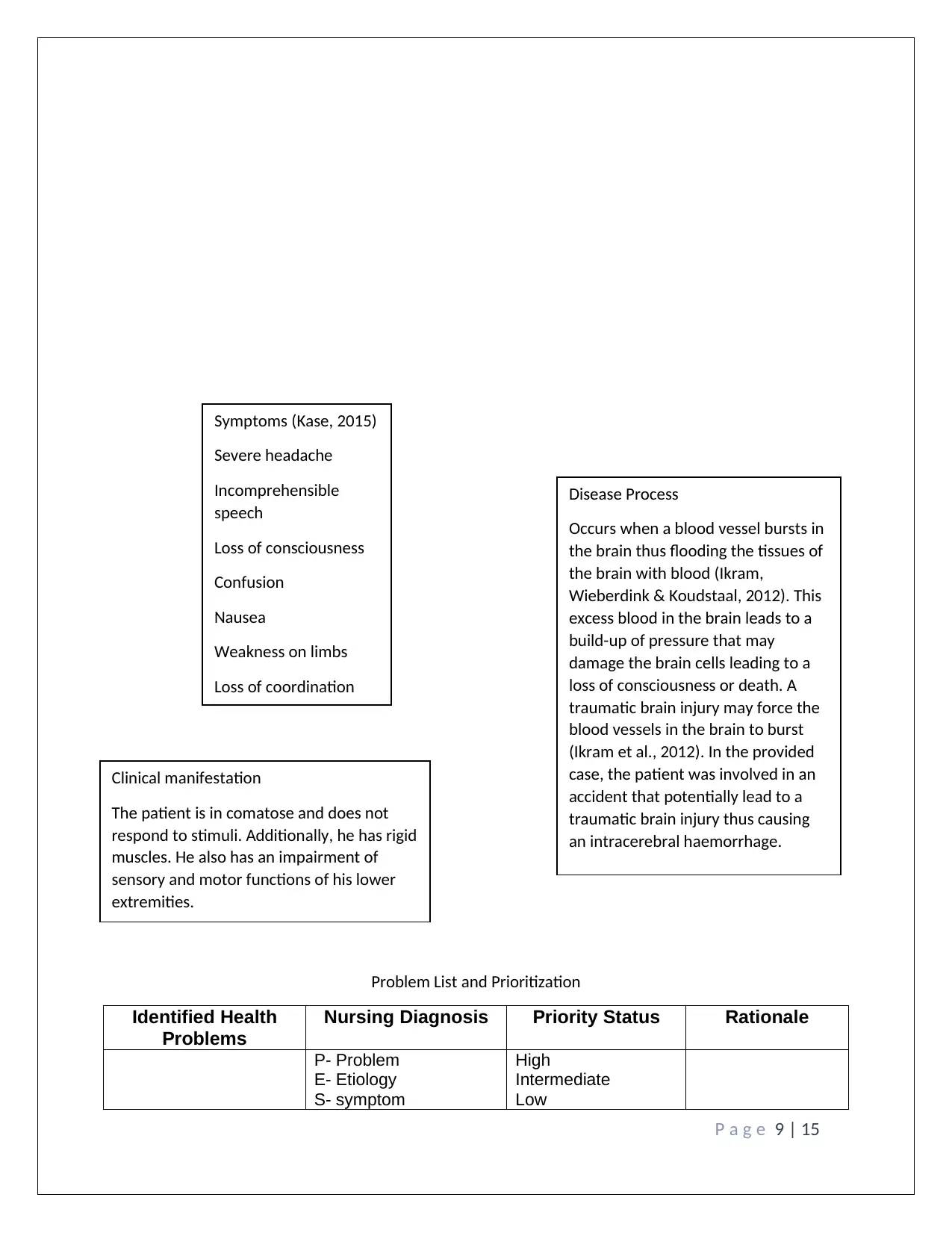
Problem List and Prioritization
Identified Health
Problems
Nursing Diagnosis Priority Status Rationale
P- Problem
E- Etiology
S- symptom
High
Intermediate
Low
P a g e 9 | 15
Symptoms (Kase, 2015)
Severe headache
Incomprehensible
speech
Loss of consciousness
Confusion
Nausea
Weakness on limbs
Loss of coordination
Disease Process
Occurs when a blood vessel bursts in
the brain thus flooding the tissues of
the brain with blood (Ikram,
Wieberdink & Koudstaal, 2012). This
excess blood in the brain leads to a
build-up of pressure that may
damage the brain cells leading to a
loss of consciousness or death. A
traumatic brain injury may force the
blood vessels in the brain to burst
(Ikram et al., 2012). In the provided
case, the patient was involved in an
accident that potentially lead to a
traumatic brain injury thus causing
an intracerebral haemorrhage.
Clinical manifestation
The patient is in comatose and does not
respond to stimuli. Additionally, he has rigid
muscles. He also has an impairment of
sensory and motor functions of his lower
extremities.
Identified Health
Problems
Nursing Diagnosis Priority Status Rationale
P- Problem
E- Etiology
S- symptom
High
Intermediate
Low
P a g e 9 | 15
Symptoms (Kase, 2015)
Severe headache
Incomprehensible
speech
Loss of consciousness
Confusion
Nausea
Weakness on limbs
Loss of coordination
Disease Process
Occurs when a blood vessel bursts in
the brain thus flooding the tissues of
the brain with blood (Ikram,
Wieberdink & Koudstaal, 2012). This
excess blood in the brain leads to a
build-up of pressure that may
damage the brain cells leading to a
loss of consciousness or death. A
traumatic brain injury may force the
blood vessels in the brain to burst
(Ikram et al., 2012). In the provided
case, the patient was involved in an
accident that potentially lead to a
traumatic brain injury thus causing
an intracerebral haemorrhage.
Clinical manifestation
The patient is in comatose and does not
respond to stimuli. Additionally, he has rigid
muscles. He also has an impairment of
sensory and motor functions of his lower
extremities.
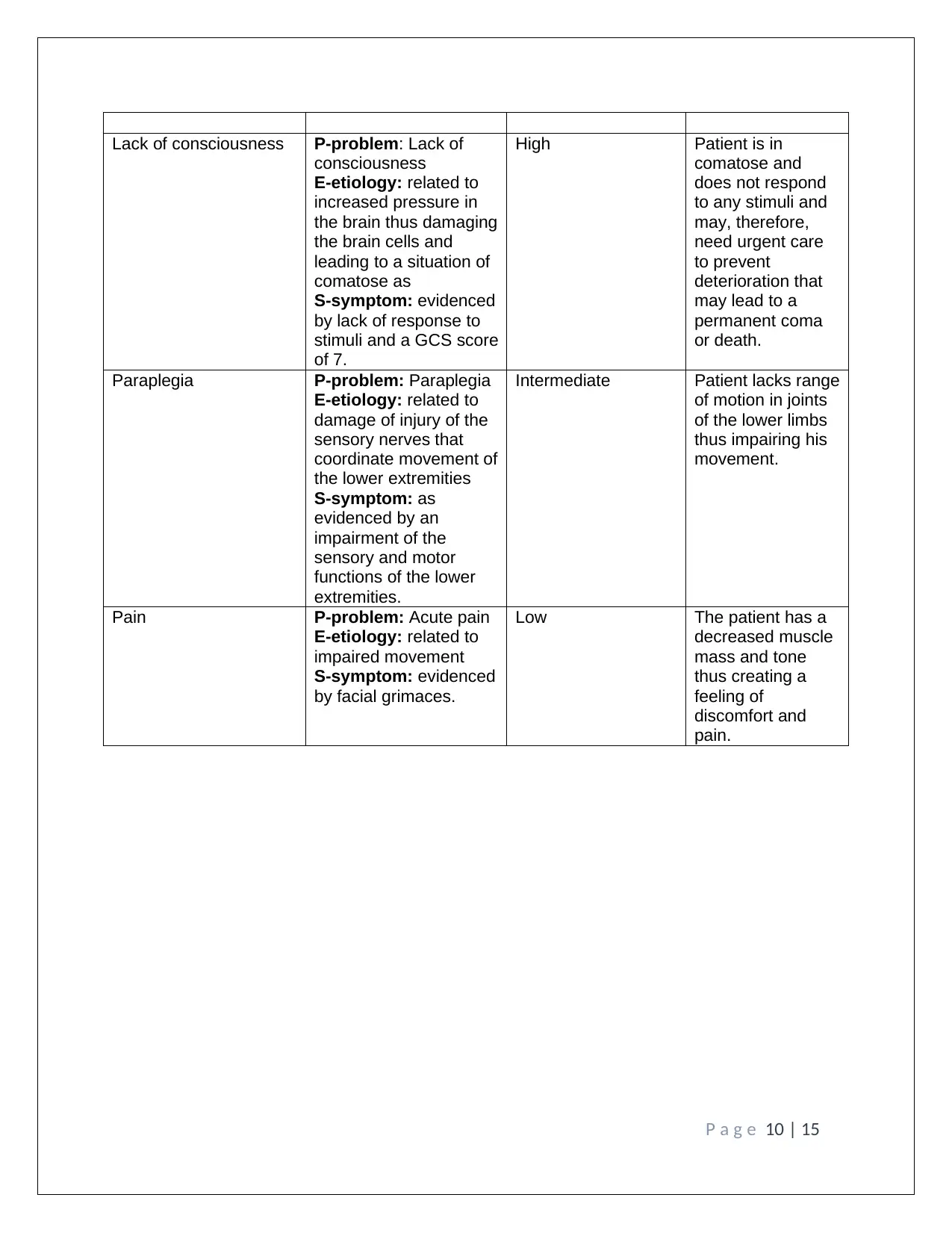
Lack of consciousness P-problem: Lack of
consciousness
E-etiology: related to
increased pressure in
the brain thus damaging
the brain cells and
leading to a situation of
comatose as
S-symptom: evidenced
by lack of response to
stimuli and a GCS score
of 7.
High Patient is in
comatose and
does not respond
to any stimuli and
may, therefore,
need urgent care
to prevent
deterioration that
may lead to a
permanent coma
or death.
Paraplegia P-problem: Paraplegia
E-etiology: related to
damage of injury of the
sensory nerves that
coordinate movement of
the lower extremities
S-symptom: as
evidenced by an
impairment of the
sensory and motor
functions of the lower
extremities.
Intermediate Patient lacks range
of motion in joints
of the lower limbs
thus impairing his
movement.
Pain P-problem: Acute pain
E-etiology: related to
impaired movement
S-symptom: evidenced
by facial grimaces.
Low The patient has a
decreased muscle
mass and tone
thus creating a
feeling of
discomfort and
pain.
P a g e 10 | 15
consciousness
E-etiology: related to
increased pressure in
the brain thus damaging
the brain cells and
leading to a situation of
comatose as
S-symptom: evidenced
by lack of response to
stimuli and a GCS score
of 7.
High Patient is in
comatose and
does not respond
to any stimuli and
may, therefore,
need urgent care
to prevent
deterioration that
may lead to a
permanent coma
or death.
Paraplegia P-problem: Paraplegia
E-etiology: related to
damage of injury of the
sensory nerves that
coordinate movement of
the lower extremities
S-symptom: as
evidenced by an
impairment of the
sensory and motor
functions of the lower
extremities.
Intermediate Patient lacks range
of motion in joints
of the lower limbs
thus impairing his
movement.
Pain P-problem: Acute pain
E-etiology: related to
impaired movement
S-symptom: evidenced
by facial grimaces.
Low The patient has a
decreased muscle
mass and tone
thus creating a
feeling of
discomfort and
pain.
P a g e 10 | 15
Secure Best Marks with AI Grader
Need help grading? Try our AI Grader for instant feedback on your assignments.
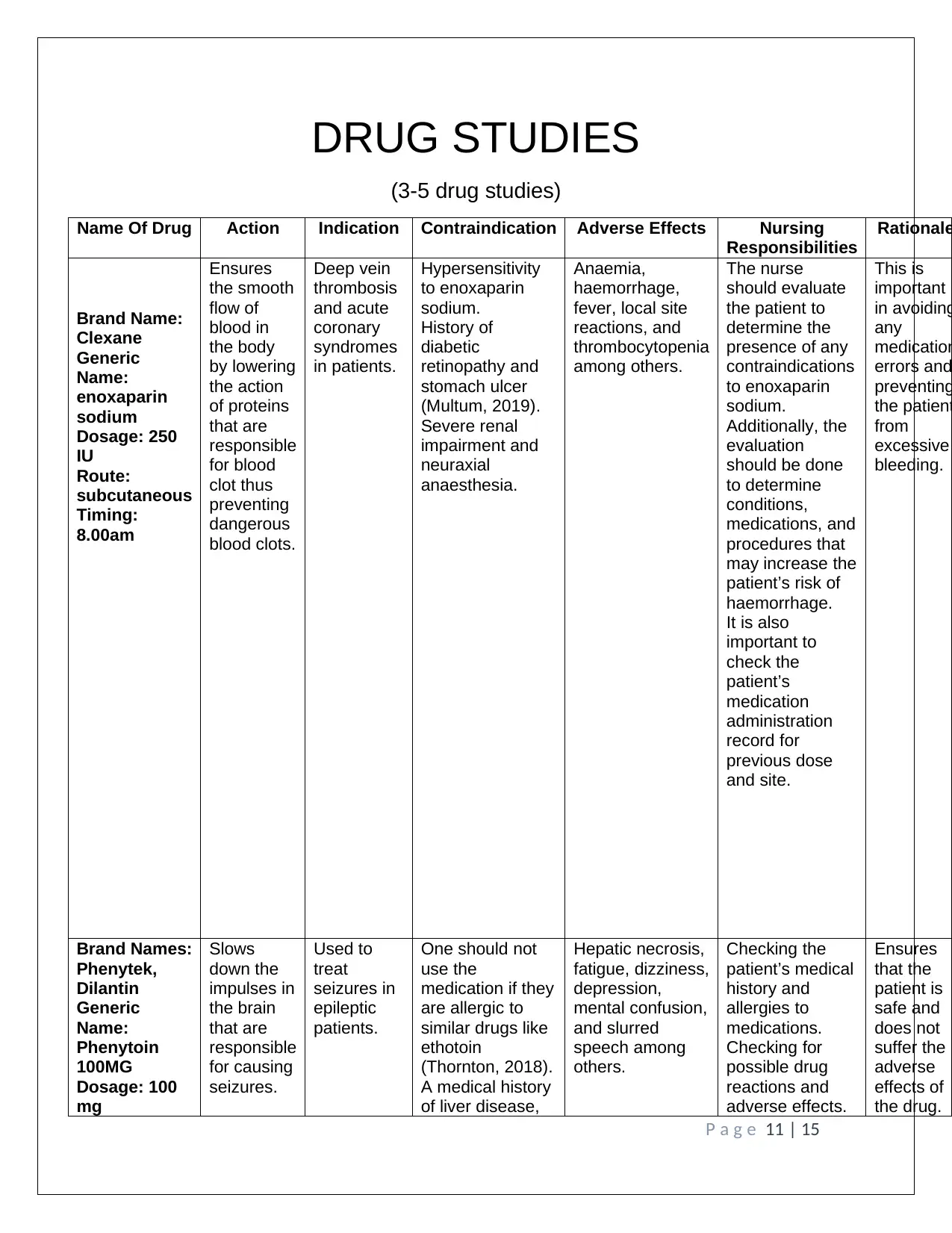
DRUG STUDIES
(3-5 drug studies)
Name Of Drug Action Indication Contraindication Adverse Effects Nursing
Responsibilities
Rationale
Brand Name:
Clexane
Generic
Name:
enoxaparin
sodium
Dosage: 250
IU
Route:
subcutaneous
Timing:
8.00am
Ensures
the smooth
flow of
blood in
the body
by lowering
the action
of proteins
that are
responsible
for blood
clot thus
preventing
dangerous
blood clots.
Deep vein
thrombosis
and acute
coronary
syndromes
in patients.
Hypersensitivity
to enoxaparin
sodium.
History of
diabetic
retinopathy and
stomach ulcer
(Multum, 2019).
Severe renal
impairment and
neuraxial
anaesthesia.
Anaemia,
haemorrhage,
fever, local site
reactions, and
thrombocytopenia
among others.
The nurse
should evaluate
the patient to
determine the
presence of any
contraindications
to enoxaparin
sodium.
Additionally, the
evaluation
should be done
to determine
conditions,
medications, and
procedures that
may increase the
patient’s risk of
haemorrhage.
It is also
important to
check the
patient’s
medication
administration
record for
previous dose
and site.
This is
important
in avoiding
any
medication
errors and
preventing
the patient
from
excessive
bleeding.
Brand Names:
Phenytek,
Dilantin
Generic
Name:
Phenytoin
100MG
Dosage: 100
mg
Slows
down the
impulses in
the brain
that are
responsible
for causing
seizures.
Used to
treat
seizures in
epileptic
patients.
One should not
use the
medication if they
are allergic to
similar drugs like
ethotoin
(Thornton, 2018).
A medical history
of liver disease,
Hepatic necrosis,
fatigue, dizziness,
depression,
mental confusion,
and slurred
speech among
others.
Checking the
patient’s medical
history and
allergies to
medications.
Checking for
possible drug
reactions and
adverse effects.
Ensures
that the
patient is
safe and
does not
suffer the
adverse
effects of
the drug.
P a g e 11 | 15
(3-5 drug studies)
Name Of Drug Action Indication Contraindication Adverse Effects Nursing
Responsibilities
Rationale
Brand Name:
Clexane
Generic
Name:
enoxaparin
sodium
Dosage: 250
IU
Route:
subcutaneous
Timing:
8.00am
Ensures
the smooth
flow of
blood in
the body
by lowering
the action
of proteins
that are
responsible
for blood
clot thus
preventing
dangerous
blood clots.
Deep vein
thrombosis
and acute
coronary
syndromes
in patients.
Hypersensitivity
to enoxaparin
sodium.
History of
diabetic
retinopathy and
stomach ulcer
(Multum, 2019).
Severe renal
impairment and
neuraxial
anaesthesia.
Anaemia,
haemorrhage,
fever, local site
reactions, and
thrombocytopenia
among others.
The nurse
should evaluate
the patient to
determine the
presence of any
contraindications
to enoxaparin
sodium.
Additionally, the
evaluation
should be done
to determine
conditions,
medications, and
procedures that
may increase the
patient’s risk of
haemorrhage.
It is also
important to
check the
patient’s
medication
administration
record for
previous dose
and site.
This is
important
in avoiding
any
medication
errors and
preventing
the patient
from
excessive
bleeding.
Brand Names:
Phenytek,
Dilantin
Generic
Name:
Phenytoin
100MG
Dosage: 100
mg
Slows
down the
impulses in
the brain
that are
responsible
for causing
seizures.
Used to
treat
seizures in
epileptic
patients.
One should not
use the
medication if they
are allergic to
similar drugs like
ethotoin
(Thornton, 2018).
A medical history
of liver disease,
Hepatic necrosis,
fatigue, dizziness,
depression,
mental confusion,
and slurred
speech among
others.
Checking the
patient’s medical
history and
allergies to
medications.
Checking for
possible drug
reactions and
adverse effects.
Ensures
that the
patient is
safe and
does not
suffer the
adverse
effects of
the drug.
P a g e 11 | 15
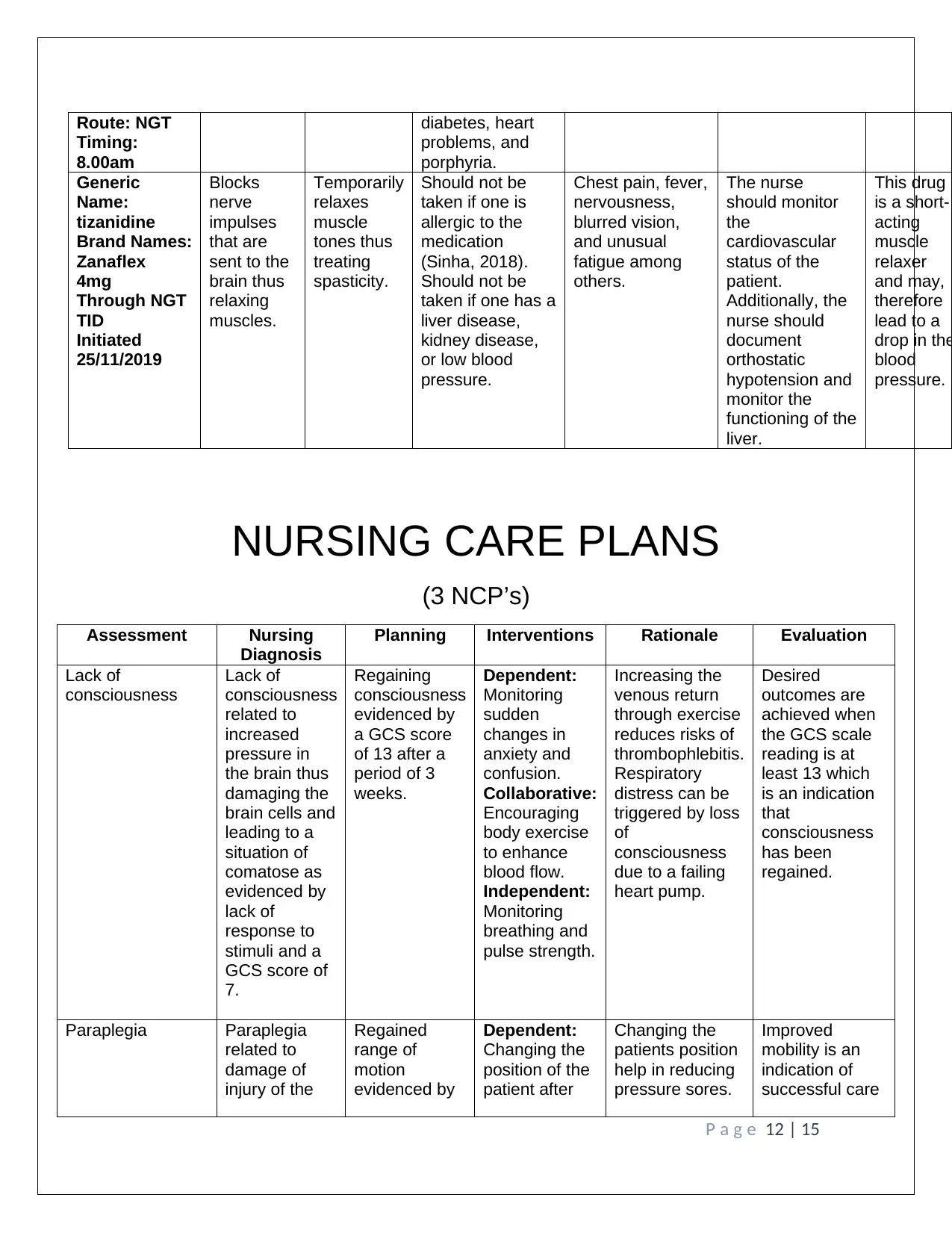
Route: NGT
Timing:
8.00am
diabetes, heart
problems, and
porphyria.
Generic
Name:
tizanidine
Brand Names:
Zanaflex
4mg
Through NGT
TID
Initiated
25/11/2019
Blocks
nerve
impulses
that are
sent to the
brain thus
relaxing
muscles.
Temporarily
relaxes
muscle
tones thus
treating
spasticity.
Should not be
taken if one is
allergic to the
medication
(Sinha, 2018).
Should not be
taken if one has a
liver disease,
kidney disease,
or low blood
pressure.
Chest pain, fever,
nervousness,
blurred vision,
and unusual
fatigue among
others.
The nurse
should monitor
the
cardiovascular
status of the
patient.
Additionally, the
nurse should
document
orthostatic
hypotension and
monitor the
functioning of the
liver.
This drug
is a short-
acting
muscle
relaxer
and may,
therefore
lead to a
drop in the
blood
pressure.
NURSING CARE PLANS
(3 NCP’s)
Assessment Nursing
Diagnosis
Planning Interventions Rationale Evaluation
Lack of
consciousness
Lack of
consciousness
related to
increased
pressure in
the brain thus
damaging the
brain cells and
leading to a
situation of
comatose as
evidenced by
lack of
response to
stimuli and a
GCS score of
7.
Regaining
consciousness
evidenced by
a GCS score
of 13 after a
period of 3
weeks.
Dependent:
Monitoring
sudden
changes in
anxiety and
confusion.
Collaborative:
Encouraging
body exercise
to enhance
blood flow.
Independent:
Monitoring
breathing and
pulse strength.
Increasing the
venous return
through exercise
reduces risks of
thrombophlebitis.
Respiratory
distress can be
triggered by loss
of
consciousness
due to a failing
heart pump.
Desired
outcomes are
achieved when
the GCS scale
reading is at
least 13 which
is an indication
that
consciousness
has been
regained.
Paraplegia Paraplegia
related to
damage of
injury of the
Regained
range of
motion
evidenced by
Dependent:
Changing the
position of the
patient after
Changing the
patients position
help in reducing
pressure sores.
Improved
mobility is an
indication of
successful care
P a g e 12 | 15
Timing:
8.00am
diabetes, heart
problems, and
porphyria.
Generic
Name:
tizanidine
Brand Names:
Zanaflex
4mg
Through NGT
TID
Initiated
25/11/2019
Blocks
nerve
impulses
that are
sent to the
brain thus
relaxing
muscles.
Temporarily
relaxes
muscle
tones thus
treating
spasticity.
Should not be
taken if one is
allergic to the
medication
(Sinha, 2018).
Should not be
taken if one has a
liver disease,
kidney disease,
or low blood
pressure.
Chest pain, fever,
nervousness,
blurred vision,
and unusual
fatigue among
others.
The nurse
should monitor
the
cardiovascular
status of the
patient.
Additionally, the
nurse should
document
orthostatic
hypotension and
monitor the
functioning of the
liver.
This drug
is a short-
acting
muscle
relaxer
and may,
therefore
lead to a
drop in the
blood
pressure.
NURSING CARE PLANS
(3 NCP’s)
Assessment Nursing
Diagnosis
Planning Interventions Rationale Evaluation
Lack of
consciousness
Lack of
consciousness
related to
increased
pressure in
the brain thus
damaging the
brain cells and
leading to a
situation of
comatose as
evidenced by
lack of
response to
stimuli and a
GCS score of
7.
Regaining
consciousness
evidenced by
a GCS score
of 13 after a
period of 3
weeks.
Dependent:
Monitoring
sudden
changes in
anxiety and
confusion.
Collaborative:
Encouraging
body exercise
to enhance
blood flow.
Independent:
Monitoring
breathing and
pulse strength.
Increasing the
venous return
through exercise
reduces risks of
thrombophlebitis.
Respiratory
distress can be
triggered by loss
of
consciousness
due to a failing
heart pump.
Desired
outcomes are
achieved when
the GCS scale
reading is at
least 13 which
is an indication
that
consciousness
has been
regained.
Paraplegia Paraplegia
related to
damage of
injury of the
Regained
range of
motion
evidenced by
Dependent:
Changing the
position of the
patient after
Changing the
patients position
help in reducing
pressure sores.
Improved
mobility is an
indication of
successful care
P a g e 12 | 15
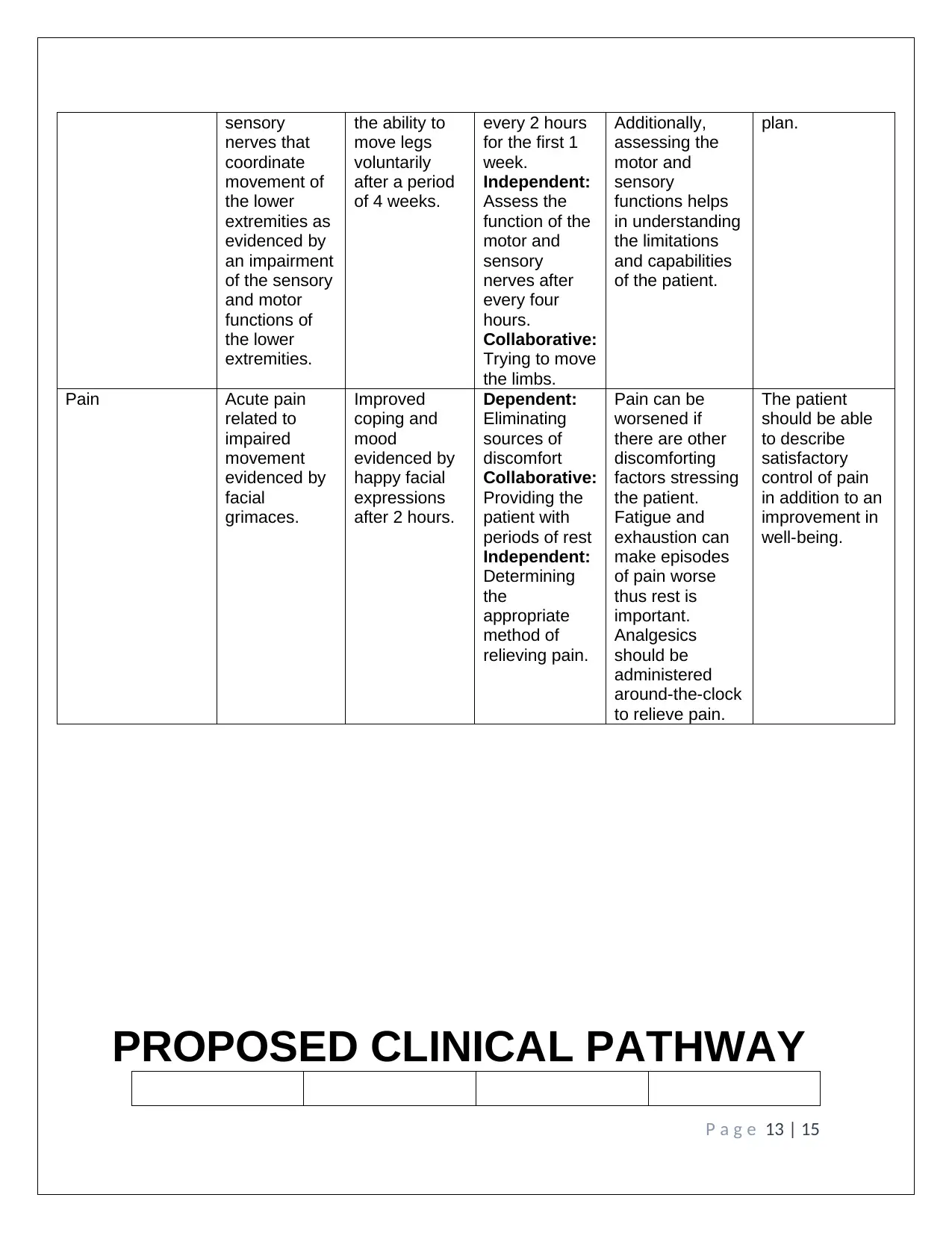
sensory
nerves that
coordinate
movement of
the lower
extremities as
evidenced by
an impairment
of the sensory
and motor
functions of
the lower
extremities.
the ability to
move legs
voluntarily
after a period
of 4 weeks.
every 2 hours
for the first 1
week.
Independent:
Assess the
function of the
motor and
sensory
nerves after
every four
hours.
Collaborative:
Trying to move
the limbs.
Additionally,
assessing the
motor and
sensory
functions helps
in understanding
the limitations
and capabilities
of the patient.
plan.
Pain Acute pain
related to
impaired
movement
evidenced by
facial
grimaces.
Improved
coping and
mood
evidenced by
happy facial
expressions
after 2 hours.
Dependent:
Eliminating
sources of
discomfort
Collaborative:
Providing the
patient with
periods of rest
Independent:
Determining
the
appropriate
method of
relieving pain.
Pain can be
worsened if
there are other
discomforting
factors stressing
the patient.
Fatigue and
exhaustion can
make episodes
of pain worse
thus rest is
important.
Analgesics
should be
administered
around-the-clock
to relieve pain.
The patient
should be able
to describe
satisfactory
control of pain
in addition to an
improvement in
well-being.
PROPOSED CLINICAL PATHWAY
P a g e 13 | 15
nerves that
coordinate
movement of
the lower
extremities as
evidenced by
an impairment
of the sensory
and motor
functions of
the lower
extremities.
the ability to
move legs
voluntarily
after a period
of 4 weeks.
every 2 hours
for the first 1
week.
Independent:
Assess the
function of the
motor and
sensory
nerves after
every four
hours.
Collaborative:
Trying to move
the limbs.
Additionally,
assessing the
motor and
sensory
functions helps
in understanding
the limitations
and capabilities
of the patient.
plan.
Pain Acute pain
related to
impaired
movement
evidenced by
facial
grimaces.
Improved
coping and
mood
evidenced by
happy facial
expressions
after 2 hours.
Dependent:
Eliminating
sources of
discomfort
Collaborative:
Providing the
patient with
periods of rest
Independent:
Determining
the
appropriate
method of
relieving pain.
Pain can be
worsened if
there are other
discomforting
factors stressing
the patient.
Fatigue and
exhaustion can
make episodes
of pain worse
thus rest is
important.
Analgesics
should be
administered
around-the-clock
to relieve pain.
The patient
should be able
to describe
satisfactory
control of pain
in addition to an
improvement in
well-being.
PROPOSED CLINICAL PATHWAY
P a g e 13 | 15
Paraphrase This Document
Need a fresh take? Get an instant paraphrase of this document with our AI Paraphraser
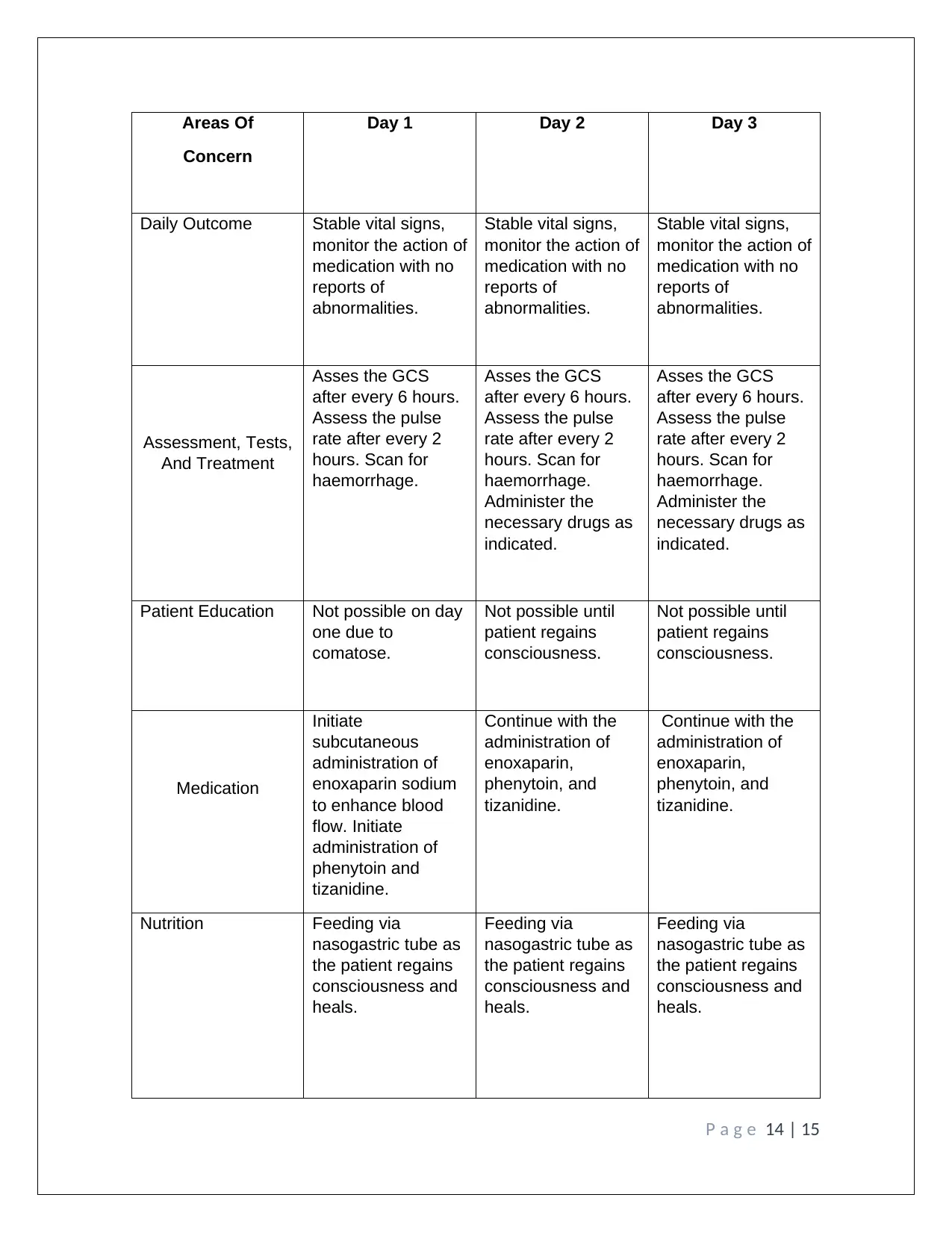
Areas Of
Concern
Day 1 Day 2 Day 3
Daily Outcome Stable vital signs,
monitor the action of
medication with no
reports of
abnormalities.
Stable vital signs,
monitor the action of
medication with no
reports of
abnormalities.
Stable vital signs,
monitor the action of
medication with no
reports of
abnormalities.
Assessment, Tests,
And Treatment
Asses the GCS
after every 6 hours.
Assess the pulse
rate after every 2
hours. Scan for
haemorrhage.
Asses the GCS
after every 6 hours.
Assess the pulse
rate after every 2
hours. Scan for
haemorrhage.
Administer the
necessary drugs as
indicated.
Asses the GCS
after every 6 hours.
Assess the pulse
rate after every 2
hours. Scan for
haemorrhage.
Administer the
necessary drugs as
indicated.
Patient Education Not possible on day
one due to
comatose.
Not possible until
patient regains
consciousness.
Not possible until
patient regains
consciousness.
Medication
Initiate
subcutaneous
administration of
enoxaparin sodium
to enhance blood
flow. Initiate
administration of
phenytoin and
tizanidine.
Continue with the
administration of
enoxaparin,
phenytoin, and
tizanidine.
Continue with the
administration of
enoxaparin,
phenytoin, and
tizanidine.
Nutrition Feeding via
nasogastric tube as
the patient regains
consciousness and
heals.
Feeding via
nasogastric tube as
the patient regains
consciousness and
heals.
Feeding via
nasogastric tube as
the patient regains
consciousness and
heals.
P a g e 14 | 15
Concern
Day 1 Day 2 Day 3
Daily Outcome Stable vital signs,
monitor the action of
medication with no
reports of
abnormalities.
Stable vital signs,
monitor the action of
medication with no
reports of
abnormalities.
Stable vital signs,
monitor the action of
medication with no
reports of
abnormalities.
Assessment, Tests,
And Treatment
Asses the GCS
after every 6 hours.
Assess the pulse
rate after every 2
hours. Scan for
haemorrhage.
Asses the GCS
after every 6 hours.
Assess the pulse
rate after every 2
hours. Scan for
haemorrhage.
Administer the
necessary drugs as
indicated.
Asses the GCS
after every 6 hours.
Assess the pulse
rate after every 2
hours. Scan for
haemorrhage.
Administer the
necessary drugs as
indicated.
Patient Education Not possible on day
one due to
comatose.
Not possible until
patient regains
consciousness.
Not possible until
patient regains
consciousness.
Medication
Initiate
subcutaneous
administration of
enoxaparin sodium
to enhance blood
flow. Initiate
administration of
phenytoin and
tizanidine.
Continue with the
administration of
enoxaparin,
phenytoin, and
tizanidine.
Continue with the
administration of
enoxaparin,
phenytoin, and
tizanidine.
Nutrition Feeding via
nasogastric tube as
the patient regains
consciousness and
heals.
Feeding via
nasogastric tube as
the patient regains
consciousness and
heals.
Feeding via
nasogastric tube as
the patient regains
consciousness and
heals.
P a g e 14 | 15
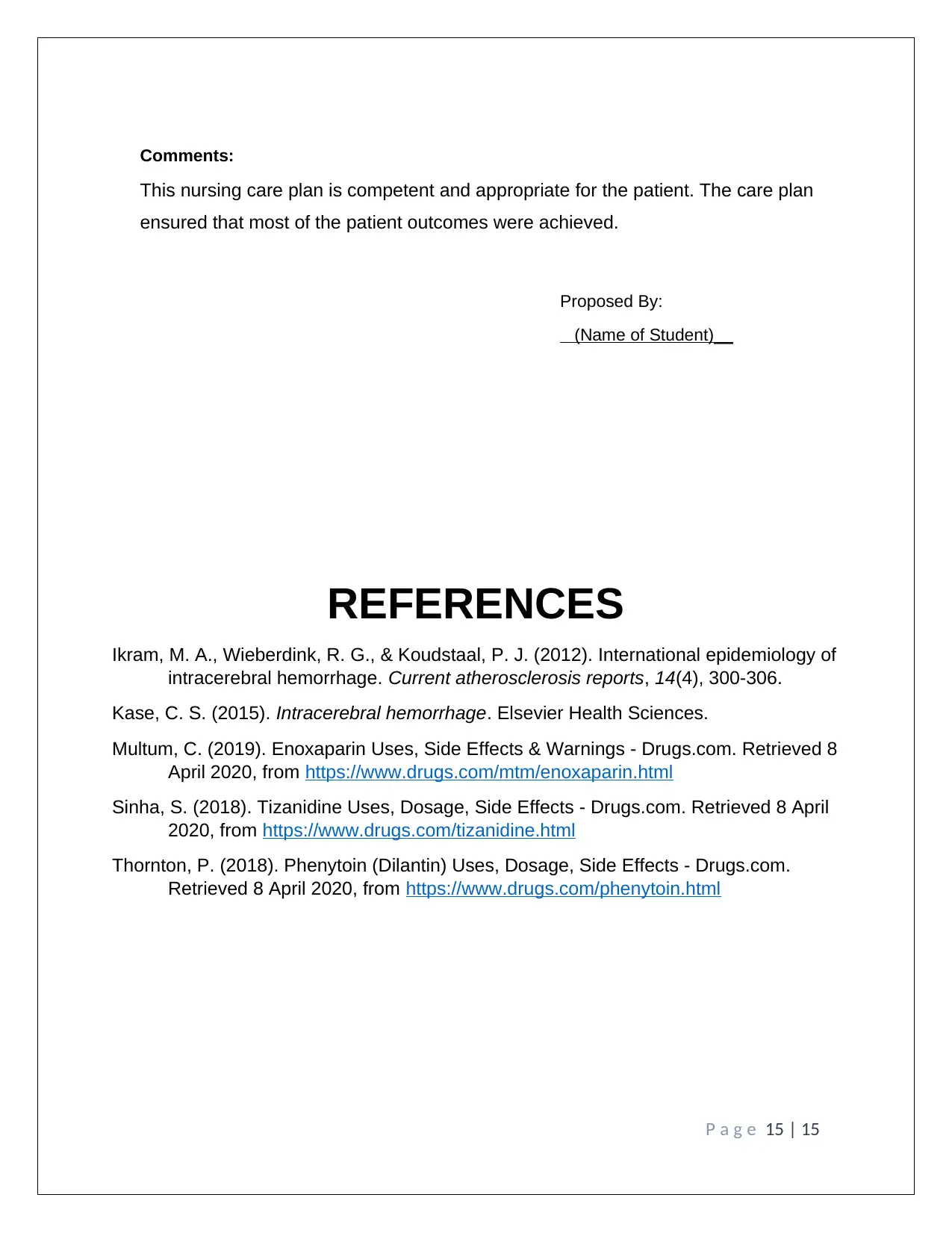
Comments:
This nursing care plan is competent and appropriate for the patient. The care plan
ensured that most of the patient outcomes were achieved.
Proposed By:
(Name of Student)__
REFERENCES
Ikram, M. A., Wieberdink, R. G., & Koudstaal, P. J. (2012). International epidemiology of
intracerebral hemorrhage. Current atherosclerosis reports, 14(4), 300-306.
Kase, C. S. (2015). Intracerebral hemorrhage. Elsevier Health Sciences.
Multum, C. (2019). Enoxaparin Uses, Side Effects & Warnings - Drugs.com. Retrieved 8
April 2020, from https://www.drugs.com/mtm/enoxaparin.html
Sinha, S. (2018). Tizanidine Uses, Dosage, Side Effects - Drugs.com. Retrieved 8 April
2020, from https://www.drugs.com/tizanidine.html
Thornton, P. (2018). Phenytoin (Dilantin) Uses, Dosage, Side Effects - Drugs.com.
Retrieved 8 April 2020, from https://www.drugs.com/phenytoin.html
P a g e 15 | 15
This nursing care plan is competent and appropriate for the patient. The care plan
ensured that most of the patient outcomes were achieved.
Proposed By:
(Name of Student)__
REFERENCES
Ikram, M. A., Wieberdink, R. G., & Koudstaal, P. J. (2012). International epidemiology of
intracerebral hemorrhage. Current atherosclerosis reports, 14(4), 300-306.
Kase, C. S. (2015). Intracerebral hemorrhage. Elsevier Health Sciences.
Multum, C. (2019). Enoxaparin Uses, Side Effects & Warnings - Drugs.com. Retrieved 8
April 2020, from https://www.drugs.com/mtm/enoxaparin.html
Sinha, S. (2018). Tizanidine Uses, Dosage, Side Effects - Drugs.com. Retrieved 8 April
2020, from https://www.drugs.com/tizanidine.html
Thornton, P. (2018). Phenytoin (Dilantin) Uses, Dosage, Side Effects - Drugs.com.
Retrieved 8 April 2020, from https://www.drugs.com/phenytoin.html
P a g e 15 | 15
1 out of 15
Related Documents
Your All-in-One AI-Powered Toolkit for Academic Success.
+13062052269
info@desklib.com
Available 24*7 on WhatsApp / Email
![[object Object]](/_next/static/media/star-bottom.7253800d.svg)
Unlock your academic potential
© 2024 | Zucol Services PVT LTD | All rights reserved.




